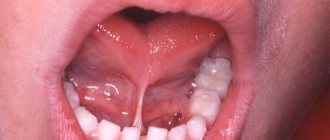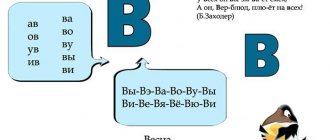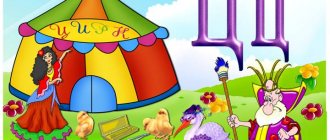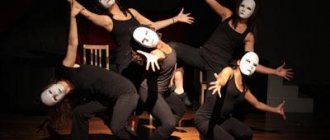Hello, dear readers! In this article I will tell you how the fungus tongue exercise and massage of the speech organs will help you to make some sounds. There comes a time for all children when they start talking. Of course, this is the most important period in speech development. Normally, a child begins to speak at ten months. Diction disorders become more noticeable by the age of two, when the baby tries to find the correct syllables, combining them into words.
If a child is unable to pronounce sounds, syllables, words and phrases correctly, then the cause may be problems in the structure of the organs of articulation, for example, reduced mobility of the tongue. This is where parents should be wary if speech is slurred, hissing sounds and the “r” sound are missing or severely distorted. The baby faces difficulties in communication, spelling, decreased self-esteem and self-confidence.
Short bridle
The reason why a child cannot pronounce a sound is weak muscles of the tongue, cheeks, lips. He has difficulty placing his lips and tongue in the correct position to produce a clear sound. Of course, a common cause of impaired pronunciation of sounds is a shortened hyoid ligament (frenulum). The normal length of the frenulum is one and a half centimeters.
Your dentist may recommend trimming the hypoglossal ligament using a laser or surgery. But it is best to do this in a newborn age, because at the age of 5 - 6 years after healing, a scar remains, which can interfere with speech. Alternatively, try stretching using articulation exercises.
With the help of exercises we will try to stretch the hypoglossal ligament. This is necessary for making the sounds “R” and “L”, as well as other hissing sounds. The effectiveness of the exercises increases if articulatory gymnastics are performed correctly.
Classes are conducted in a well-ventilated, lighted room. The child sits in front of the mirror on a comfortable chair so that his feet reach the floor. At the very beginning, the child and the adult should sit in front of the mirror, the child looks and repeats the movements. When performing the “Mushroom” exercise, the baby should smile and open his mouth wide. Then suck the tongue to the roof of your mouth.
Click your tongue, do the “horse” exercise if it doesn’t work out right away. Then repeat the “mushroom” again. You can support the tongue from below with a spoon, spatula or massage probe. The exercise does not always work out right away, so that the child is not distracted; you can show a picture of mushrooms, tell about them, how they grow, how they are collected, and put in a basket. In the following classes you can tell poems and riddles about fungus. Play collecting toy mushrooms in a box.
Instructions for performing articulation gymnastics
1. It is necessary to carry out articulatory gymnastics in such a way that you can see how each child performs each exercise.
2. If children do not perform an exercise well enough, the teacher does not give new exercises, but practices old material.
3. If the teacher sees that the group is mostly coping with the exercise, and only some children are not doing it well enough, he does additional individual work with them or instructs parents to practice this movement at home, allotting 2-3 minutes to complete it. daily.
4. For one lesson, take 4-5 exercises for 10-15 minutes.
5. When performing articulatory gymnastics, it is necessary to ensure that the movements of each organ of the articulatory apparatus are performed symmetrically in relation to the right and left sides. If a child’s tongue or lips deviate to the left or right, then it is necessary to practice these movements individually, in front of a mirror. Fomicheva M.F. "Education of correct pronunciation in children."
The importance of gymnastics for the language
Exercises for the tongue (to prepare for the pronunciation of whistling sounds: s, z, ts).
“Needle” - stick your tongue far forward, tense it, make it narrow. Hold for 10-15 s. “Spatula” - stick out your wide tongue, relax it, smack your lips, and place it on your lower lip. Hold for 10-15 seconds..
“Swing” - open your mouth, stick out your tongue. Reach your tongue alternately to your nose and then to your chin. Place your tongue in your mouth. Stretch your tongue either towards the upper or lower incisors. Perform for 10-15 seconds.
“Snake” – open your mouth. Push your tongue forward and move it deep into your mouth (10-15 seconds).
“Who will kick the ball further?” – blow from a wide tongue onto a piece of cotton wool or paper so that it moves across the table (5 times).
“Reel” - mouth open. The tip of the tongue is behind the lower incisors. The tongue is wide. The tongue “rolls out” forward and retracts into the mouth (like a coil) 10-15 times. (First the large coil, then the small one).
“Pump” - breathe through your nose with your mouth open (the tongue reflexively curves in a “slide”). Then “blow” along the curved tongue (10-15 seconds).
“Tube” - roll the tongue into a tube, bending its edges (10-15 sec.).
“Chick in the nest” - the mouth is open, the tongue lies quietly in the mouth (10-15 sec.).
“Don’t make noise” - say “ts-ts-ts-ts-ts-ts”, putting your finger to your lips (10 - 15 times). “Let’s brush your teeth” - use the tip of your tongue to move the bottom teeth up and down from the inside (10-15 seconds).
Exercises for the tongue (to prepare for pronunciation R).
“Horse” - suck your tongue to the roof of your mouth, click your tongue. Click slowly, firmly. “Mushroom” – suck your tongue to the roof of your mouth, open your mouth wide (10-15 sec.). “Delicious jam” - stick out your wide tongue, lick your upper lip from top to bottom and remove your tongue (10-15 times). “Painter” - slow movements with the tip of the tongue across the palate from the upper incisors to the “neck” and back (10-15 times). “Who will kick the ball further?” – blow from a wide tongue onto a piece of cotton wool or paper so that it moves across the table (5 times).
“Glue the candy” - with the wide tip of your tongue, touch the tubercles in your mouth located behind the upper incisors (10-15 seconds). “Monkey” – place the tip of your tongue under your upper lip and hold for 10 – 15 seconds. “Strong tongue” - forcefully press the tip of the tongue against the upper incisors (10 - 15 s). “Let’s brush your teeth” - use the tip of your tongue to move along the upper incisors from the inside down - up (10 - 15 sec.).
“Turkey” - a) with the wide tip of the tongue, quickly move the upper lip back and forth, b) behind the teeth, quickly move the tongue back and forth (10 - 15 sec.). “Drummers” - we quickly say “d-d-d”, exhaling the air strongly for the last time. “Motor” -1) pronounce “zh” with your mouth open and rotate your arms in front of your chest, 2) pronounce “zh” with your mouth open and touch your tongue with your finger (10–15 s). “Balalaika” - the tip of the tongue - up behind the teeth, touch the tongue with your fingers a) without a voice; b) with voice (10 – 15 sec.).
“Fork” - to avoid strong vibration of the edges of the tongue, hold the tongue from the sides with your fingers: put 2 fingers under the tongue, press it from below to the molars. We use it when performing the “Horse” exercise, when pronouncing [rr-r-r]. “Learning to play the harp” - say “d-d-d-d”, each time touching your tongue with your finger. “Let's score the ball” - the mouth is closed, the elastic tongue rests on one or the other cheek. “We shoot” - we slowly pronounce: “j-j-j”, exhaling air strongly, trying to make the tongue tremble (10 - 15 sec.). “We play the harp” (or “start the engine”) - slowly move the tongue behind the upper incisors “drl-drl-drl” (10 - 15 sec.). “Dragonfly” - say “tr-rr-r” in a whisper, and then loudly (10 - 15 sec.).
Exercises for the language (to prepare for pronunciation L).
“Painter” - use the tip of the tongue to move across the palate from the upper incisors to the “neck” and back. Slowly (10-15 times). “Glue the candy” - use the tip of your tongue to touch the upper incisors on the inside, hold your tongue in this position (10-15 seconds). Honk "l-l-l." “Cycle” – open your mouth, make a “cup” of your tongue, bend its edges and tip (10-15 sec.). Move the cup up behind the teeth, connect the voice “l-l-l-l-l” - “The steamer is humming.” “Tube” - roll the tongue into a tube, bending its edges (10-15 sec.). “Chick in the nest” - the mouth is open, the tongue lies quietly in the mouth (10-15 sec.).
“Focus” – place a piece of cotton wool or paper on the child’s nose. The child must blow it off his wide tongue (5 times).
“The plane is humming” - hold the tip of your tongue between your teeth and hum “l-l-l-l-l”. You can straighten your arms and “fly” around the room. “Learning to hum” - 1) clench your teeth, press the tip of your tongue against the upper incisors from the inside, hum “l-l-l”; 2) say “n-n-n”, hold your nose, continue humming (the air will go through the mouth, you will get “l-l-l”) (10 - 15 sec.). “Push out the teeth with the tongue” - firmly press the tip of the tongue against the upper incisors from the inside and hum “l-l-l-l-l” (10 - 15 sec.).
Say “zh-zh-zh”, press your tongue more tightly to the palate (with a finger or probe, the tip of a spoon), continue to hum “l-l-l” (10 - 15 sec.). “Monkey” – place the tip of your tongue under your upper lip and hold for 10 – 15 seconds. “Strong tongue” - forcefully press the tip of the tongue against the upper incisors (10 - 15 s). “Let’s brush your teeth” - use the tip of your tongue to move along the upper incisors from the inside down - up (10 - 15 sec.).
Exercises for the tongue (to prepare for pronouncing hissing sounds: sh, zh, ch, shch).
“Spatula” – stick out your wide tongue, relax it, smack your lips, and place it on your lower lip (10-15 seconds). “Needle” - tense your tongue, make it narrow (10-15 sec.). “Swing” – 1) open your mouth, stick out your tongue. Reach your tongue alternately to your nose and then to your chin. 2). Place your tongue in your mouth. Stretch your tongue alternately to the upper and lower incisors (10-15 times).
“Painter” - movements of the tip of the tongue across the palate from the upper incisors to the “neck” and back. Slowly (10-15 times). “Glue the candy” - with the wide tip of your tongue, touch the tubercles in your mouth located behind the upper incisors, hold your tongue in this position (10-15 seconds).
“Who will kick the ball further?” – blow from a wide tongue onto a piece of cotton wool or paper so that it moves across the table (5 times).
“Focus” – place a piece of cotton wool or paper on the child’s nose. The child must blow it off his wide tongue (5 times).
List of literature used in the compilation of articulatory gymnastics.
Source
"Mushroom" with passion
Sometimes this will take quite a long time; unfortunately, not everyone has enough pictures. There are overly active children who are unable to sit and do the exercise. They get bored. You can try making “Mushroom” at home using game techniques. Make up a fairy tale. Put on a puppet show using cocktail umbrellas, for example.
Show a cartoon about a fungus. Every parent knows what their child loves. Take advantage of this, get interested, outwit and try to repeat the exercise.
The “Mushroom” exercise is the most effective in stretching the hyoid frenulum. It is important to do it correctly and regularly.
Before performing the “Mushroom” exercise, do a short warm-up for your tongue. The process will become more fun and interesting by telling a fairy tale.
The Tale of Little Mushroom
Once upon a time there lived a small mushroom in a pine forest. And he really wanted to grow up quickly, but didn’t know how. There were rumors in the forest about the old and wise old man Borovichka. The fungus went on a search. For several days and nights he walked through the forest, asking all the mushrooms he encountered along the way. Unfortunately, no one knew where the old man lived. Coming out to the edge of the forest, an old man named Borovichok sat near a tall spruce tree on the sun-warmed grass.
Mushroom was delighted and ran as fast as he could towards him. Mushroom asked how he could grow up faster. The old man frowned, became thoughtful and said: “With the first warm rain you will begin to grow.” First, your cap will stretch upward, and then your leg will begin to stretch out and grow.” Mushroom thanked the old man and went home. As Borovichok said, with the first warm rain the Fungus began to grow and grew into a large beautiful boletus.
Using a fairy tale as an example, show your child the “Mushroom” exercise. Only the tip of the tongue is a cap. The mushroom stalk is the sublingual ligament.
Massage of the hypoglossal ligament
In order to quickly stretch the ligament, massage under the tongue is required. Sequence of massage:
- Open the baby's mouth;
- Pull out your tongue and place it on your upper lip so that the frenulum is visible.
- Cover your tongue with a handkerchief, holding it with your fingers, and with your other hand (index finger and thumb) slide along the frenulum in different directions with stretching movements.
You can massage using massage probes or attachments.
The problem of pronunciation of sounds in children of preschool and school age always remains relevant. Therefore, how a child speaks correctly in the future is entirely the responsibility of the parents. Speech therapy knowledge will help overcome disorders and correct speech. Be sure to repeat the exercise at home, and your baby will quickly learn to speak correctly.
Subscribe to our blog, there are many more interesting articles that everyone should read. Take care of your children and all the best!
Here are other articles with more detailed descriptions of the exercises: cup horse accordion delicious gymnastics lip exercises standard gymnastics
Archive number No. 23 (1390) dated June 8, 2021 - Zdoroviechko
Speech therapy
To pronounce sounds correctly, the coordinated work of all articulatory organs is necessary.
There is no way to do this without training! [td]
If your child is already 5 years old, and he still does not clearly pronounce some sounds, they are distorted or blurred, you should definitely go to classes with a speech therapist (he will put on the sounds). You can work with your baby at home on your own if you have speech impediment from the age of 3–4 years. Then, perhaps, you won’t need a speech therapist. And after 6 years, correcting pronunciation will be much more difficult.
For lessons at home, you will need a mirror, a playful mood and the child’s desire to study. Speech training is carried out 1-2 times a day. The duration of one lesson is from five to twenty minutes. At first, take one exercise. Learn something new every week or every three days. Repeat the exercise you mastered in previous days.
Entertaining static
Start with static exercises. In them, the articulatory pose is held for a count of 3 to 20. The holding time increases gradually. Static exercises help strengthen the muscles of the articulatory apparatus, as well as form the correct patterns of speech sounds.
• "Window".
Open your mouth wide and continue to maintain this position.
• "Fence".
The lips stretch into a smile, the teeth remain tightly clenched.
• “Proboscis.”
Clench your teeth tightly, stretch your lips forward, like a baby elephant’s proboscis.
• "Pancake."
Calmly place your wide, outstretched tongue on your lower lip, your mouth half open.
• "Trap".
Bite the wide tongue on the side edges with the molars, while the tip of the tongue is lowered behind the lower incisors.
• "Angry kitten."
The tip of the tongue rests on the lower incisors, the wide back of the tongue is sharply arched, the mouth is open, the lips are stretched to the sides.
• "Sting".
Open your mouth slightly, stick your sharp tongue out of your mouth (as far as possible).
• "Calyx".
Open your mouth wide, raise your tongue in the shape of a curved cup to the upper lip (the lower lip does not help him in this matter).
• "Fungus".
The mouth is open, the wide tongue is firmly attached to the palate with the upper surface, the hyoid frenulum is stretched - like a mushroom on a long stalk.
• "Tube".
Curl the tongue (looks like a hollow tube), round the lips around the tongue, they help hold a difficult pose. All these are basic exercises of the articulation school.
Dynamic and exciting
By combining two static exercises into a single bunch, we get dynamic compositions.
• “Fence” – “Proboscis”.
Clench your teeth tightly. At the count of “one-two,” the lips either stretch into a smile or stretch forward. Make sure that the teeth do not open throughout the entire combination, and that facial expressions are natural (the child should not squint his eyes).
• “Pancake” – “Tube”.
This link is one of the most difficult.
If you can’t do it, start learning easier cascades: “Pancake” • “Sting”, “Pancake” - “Cup”, “Pancake” - “Mushroom”.
When the baby can do them flawlessly, return to the difficult link.
All cascades are performed in a one-two count. Slowly at first, with a clear fixation of each pose. From lesson to lesson, the speed at which the child performs the exercises increases.
Has your child already mastered these exercises and does them with ease? Then it’s time to move on to the second, more complex part of speech therapy.
Tongue is a hard worker
There are exercises that initially involve energetic work of the tongue, it works in tandem with the lower jaw or lips.
• "Swing".
The narrow tongue alternates between the nose and the chin. The lower jaw is lowered, its position is fixed, the mouth is wide open.
• "Painter".
Open your mouth wide. A long narrow tongue, like a painter’s brush, carefully “paints” the palate along and across. The lower jaw is motionless.
• "Snake".
Stick your narrow tongue out of your mouth as much as possible. It makes rapid oscillatory movements from side to side (as a snake does with its tongue). The mouth is slightly open, the lower jaw is motionless. The lips are stretched to the sides.
• "Turkey".
We throw the wide tongue out of the mouth and hit the upper lip, making the characteristic sounds of an angry turkey: “bl-bl-bl.” The lower jaw is lowered and does not move in time with the tongue.
Everyone is training!
The lips and lower jaw also need articulation exercises. Let's help them work more dynamically.
• "Fish".
Clench your teeth tightly, stretch your lips forward (see exercise “Proboscis”). The lips open and close (as a fish does with its mouth in an aquarium).
• "Funnel".
Pull out the lower jaw, open your mouth slightly, and open your teeth. On the count of “one” we pull our lips forward, on the count of “two” we pull our lips inside the mouth, tucking them behind the teeth. Do at least 10 repetitions.
• “Annoyance.”
Bite your upper lip with your lower front teeth at least 10–15 times. The lower jaw is pushed forward as much as possible.
• "Timpani".
Lightly wrap your lips behind your teeth and inside your mouth. Slap them one against the other, making a characteristic patting sound. Repeat at least 10 times.
• “Snorting horse.”
Relax your lips and snort, imitating a horse. Repeat at least 10 times.
• “Latch.”
Move the lower jaw forward as far as possible. Move it from side to side at least 10–15 times with maximum amplitude.
• “Hide and Seek”.
There are three options here:
1) hide the upper lip by biting it with the lower front teeth. Only the lower lip is visible; it stretches upward towards the nose. Hold this position for at least 5 seconds.
2) hide the lower lip by biting it with the upper front teeth. Only the upper lip is visible, it stretches down to the chin. Hold this position for at least 5 seconds.
3) hide the upper and lower lips, drawing them into the mouth and slightly squeezing them with the front teeth. Hold this position for at least 5 seconds.
• "Plane".
Scratch the lower central teeth along the upper lip at least 10-15 times. The lower jaw moves forward and works energetically. Then repeat the same with the lower lip, but it will need to be “treated” with the upper teeth.
Demonstration performances
If, after two to three months of training, the child has successfully mastered the school and free program, it’s time to move on to staging demonstration numbers. These are entire mini-performances with the participation of articulatory organs and, of course, the child himself. But who is the main character here? Gnome Tongue!
• "Pancakes".
Gnome Tongue bought dishes at a hardware store. Now he is learning to cook his own food. Tongue's favorite thing is to bake pancakes in a new frying pan. The pancakes turn out rosy and round. The tongue lubricates each of them with oil (the wide tongue is spread out on the lower lip, both lips slap the pancake: “five-five-five”). Tongue eats pancakes with jam.
• "Tasty!"
Open your mouth slightly and lick your upper lip from top to bottom with your wide tongue at least 5 times. Make sure that your lower lip does not “stick” your tongue. Pancakes Tongue washes down with tea. If the tea is too hot, the tongue blows on it (the position of the articulatory organs is as in the “Cup” exercise; blow on the edges of the tongue without inflating the cheeks).
• “To the forest to pick mushrooms.”
The gnome Tongue loves to pick mushrooms. He takes a large basket (exercise “Cup”) and goes into the forest. On the way, he has to cross a stream. Exercise “Stream”: lips smile, teeth are almost clenched, the tip of the tongue rests on the base of the lower front incisors. Pronounce the sound “s” for a long time. At the same time, a trickle of air flows down the tongue, in the middle of the lower lip and along the chin. The water in the stream is cold. The child puts his palm under his chin and checks whether the water in the stream is really cold. The main thing is not to forget to pronounce the sound “s” for a long time! To avoid getting his feet wet, Tongue uses a bridge.
• "Bridge":
the tongue arches sharply, resting its tip against the base of the lower front incisors. Open your mouth as wide as possible.
There are so many mushrooms in the forest! Here is a strong boletus hiding under the tree (exercise “Mushroom”), and next to it is a chanterelle. There is also russula and saffron milk (the child performs the “Mushroom” exercise several times at short intervals). Arriving home, the gnome Tongue prepares a lot of delicious dishes from the collected mushrooms (exercise “Delicious!”).
Using the listed exercises, you can easily create free and demonstrative programs for your baby’s articulatory organs. Just don’t forget that the main judge of all these competitions and performances is a mirror. Only with its help can you evaluate the purity of each element. The mirror will also help you cope with the articulation of difficult sounds, and soon your speech will be clear and correct.
moirebenok.ua
Share link:
Subscribe to “For Each Other”:
Yandex News Yandex Zen Google News YouTube Video











